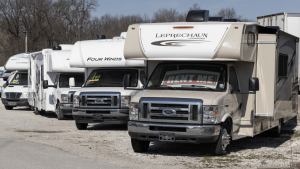Camper FAQs is reader-supported. Buying through links on our site may earn us an affiliate commission. As an Amazon Associate I earn from qualifying purchases.
When purchasing a new rooftop air conditioner unit for your RV, there are several factors you should consider to ensure you buy the best one for your needs.
It involves understanding the technical specifications, compatibility, efficiency, and additional features of AC units – which might seem a bit complicated.
But, it’s actually easy to understand once you break it down into into a few simple buying steps.
How Do I Choose an RV Air Conditioner?
Step 1: What’s Your Budget?
A new RV air conditioner isn’t a purchase to be taken lightly. They average between $800 and $1500, with some higher-end models being more expensive than that!
But, there are a few other price considerations that many overlook:
- Installation and Additional Expenses: Factor in the cost of professional installation and any necessary accessories, which can significantly impact the total investment.
- Efficiency vs. Upfront Cost: Higher-priced units often offer better energy efficiency, leading to lower operational costs over time. Although they have a higher initial cost, they can be more economical in the long run.
- Total Cost of Ownership: Consider not just the purchase price, but also maintenance and energy costs over the unit’s life. A cheaper upfront cost might lead to higher expenses down the line.
So, determine a budget that accounts for both the purchase and installation costs, while also considering potential savings from energy efficiency and durability.
Step 2: Compatibility with Your RV
Now let’s make sure the new AC unit, whether you’re replacing a current one or adding on a new one, will fit on your RV.
- Vent hole size: If you’re replacing a unit, most RV air conditioners fit in a standard 14 1/4″ x 14 1/4″ vent hole. However, some may have a bigger opening requirement. Let me tell you, matching this up will make the installation process a lot easier if you do it yourself.
- Unit dimensions: Look at the dimensions of the unit to ensure it won’t run into any other roof components. This shouldn’t be an issue if you’re replacing the current unit with one of similar dimensions.
- Weight: Be mindful of the weight of your new unit. Preferably find one in the same ballpark as your existing unit to avoid any issues.
Step 2: Selecting the Right Capacity
The cooling capacity of an AC unit is measured in British Thermal Units (BTUs). A higher BTU rating means more cooling power. A general rule of thumb is to have 50-60 BTUs per square foot of living space.
So, for example, a 30-foot long by 9-foot wide RV would typically require a 15,000 BTU air conditioner, while a 20-foot long by 8.5-foot wide RV would require a 10,000 BTU air conditioner.
Tip: If you’re replacing an existing unit, there’s no need to overthink this. Just match what you currently have. Or if you feel like it didn’t keep up, go slightly bigger.
Step 3: Consider Noise Level
Also, don’t forget about noise levels. When evaluating noise level, you’re looking at how many decibels (dB) an air conditioner unit emits while operating.
Some models are designed to be ultra-quiet, operating at noise levels as low as 50 dB – that’s quieter than the average conversation at home! Others may produce sound around 60-70 dB, which is about as loud as normal conversation or background music.
While a low-noise level air conditioner is often more comfortable, remember that it can sometimes come at the expense of power. This is because to reduce noise, manufacturers may have to downsize the fan or compressor, key components in the cooling process. A balance between noise level and cooling capacity should be sought based on your specific needs and tolerance for noise.
Step 4: Installation and Maintenance
- Ease of Installation: Some units are easier to install than others. If you’re planning to install the unit yourself, consider one that is user-friendly and comes with comprehensive installation instructions.
- Maintenance Requirements: Look for units that are easy to maintain, with accessible filters and parts. Regular maintenance is crucial for the longevity and efficiency of the AC unit.
Step 5: Warranty & Support
Finally, consider the product warranty. Extra peace of mind can go a long way in ensuring your summer travel is all about fun and zero about worry.
Prices for rooftop AC units vary widely based on their features, capacity, and efficiency. Determine your budget beforehand, but remember that investing in a more efficient and durable unit can save money in the long run on energy costs and replacements.
Step 7: Extra Features to Consider
1. Heat Pump
Some rooftop AC units come with a built-in heater, which can be beneficial for use in cooler temperatures.
2. Non-Ducted vs. Ducted
Air conditioners can also be classified into non-ducted and ducted types. Non-ducted application means the cool air is blown directly from the unit, usually installed on the roof or window. Ducted models distribute air via ducts installed throughout your RV, ensuring a more evenly-cooled space.
Make sure you know what your current setup has if you plan on a simple AC replacement.
3. Regular Vs. Low Profile AC Units
Choosing between regular and low-profile air conditioners for your RV comes down to understanding your specific needs and preferences.
- Regular AC Units: Regular AC units, with their larger stature, typically offer a higher BTU rating and robust cooling performance. They’re ideal for larger RVs or extremely hot conditions. Although their larger size may impact vehicle aerodynamics, their cooling power and durability often compensate for it.
- Low Profile AC Units: These units sit closer to the roof, offering improved aerodynamics and the ability to easily pass under low clearance areas. They may not offer the same cooling capacity as regular units, but they’re an excellent choice for smaller RVs or travelers prioritizing fuel efficiency and sleek design.
4. Remote Control and Digital Thermostats
These features offer convenience in adjusting settings without having to physically interact with the unit.
5. Air Purification
Certain models come with built-in air filters and purifiers to improve air quality inside the RV.
Popular RV AC Units to Consider
Dometic, Coleman, and Furrion are some of the top RV air conditioner brands right now. Below is a quick look at their most popular and highly rated models.
Comparison Chart
*Buying through links in this chart may earn us a commission at no additional cost to you.
1. Dometic Brisk II Rooftop Air Conditioner
- Best Choice
Dometic has become one of the most popular manufacturers in the RV industry in recent years, and they deserve it. All Dometic air conditioners are high-quality, reliable units, so you really can’t go wrong with any of them. With that said, the Dometic Brisk II tops our list of the best RV air conditioners.
This lightweight unit produces 13,500 BTU of cold air per hour. The smart design maximizes airflow and ensures peak performance. Compared to previous models and most of its competitors, this reengineered RV rooftop AC unit moves 15% more air through your motor home.
To make the Brisk II even better, it includes dampening brackets to reduce noise and vibration inside your rig. This ensures you have a smooth-running and quiet RV AC.
Plus, its 2-year warranty will ensure your investment will keep you cool through many travels.
Video Overview
Key Features
- The fan runs without the compressor on for air circulation when you don’t need the full AC
- Easy installation
- Enhanced air circulation
- Black or white color options
- Works with both ducted and non-ducted RVs
Specifications
- Weight: 77 pounds
- Capacity: 13,500 BTUs
- Dimensions: 29 5/8″ long by 27 5/8″ wide by 13 7/8″ high
- Power: 115 volts
Pros
- Quiet
- 2-year warranty
- Easy to install
Cons
- No heat pump
- Control unit sold separately

Dometic Brisk II Rooftop Air Conditioner
Price:Clicking this link to make a purchase may earn us a commission at no additional cost to you.
2. Furrion CHILL Rooftop Air Conditioner
- Best Value
In the past, RV air conditioning units were known to be noisy, heavy, and extremely energy inefficient. The Furrion CHILL Rooftop air conditioner proves that today’s models have none of those characteristics.
The Furrion Chill AC unit was designed with a 50% higher cooling capacity, 40% more energy efficiency, and 50% quieter than similar models.
Their VibrationSmart technology protects the unit from rough roads, while ClimateSmart technology protects internal components from water, UV rays, heat, and debris.
Plus, to protect your RV’s energy stores, Furrion built in a start capacitor. This feature helps start the AC without the typical large power draw that comes with turning on a unit. You can use this air conditioner even when a campsite hookup or your generator doesn’t have adequate power.
Key Features
- Two fans for ultimate cooling efficiency
- Black or white color options
- Short cycle with a boosting start capacitor
- Quiet design is rated at 80db
- Easy installation
- 2-year warranty
Specifications
- Weight: 82 pounds
- Capacity: 14,500 BTUs
- Dimensions: 34-13/16 long by 27-1/2″ wide by 13-1/2″ high
- Power: 115 volts
Pros
- Two fans
- Low profile rooftop design
- UV-resistant cover
- Eco-friendly refrigerant
Cons
- Heavy unit

Furrion CHILL Rooftop Air Conditioner
Price:Clicking this link to make a purchase may earn us a commission at no additional cost to you.
3. Coleman Mach 3 Plus 13.5k BTU Upper A/C Unit
- Best Choice for Off-Road
For some, their perfect RV getaway does not involve a luxury park with paved spaces and hookups. Many people like to take their rig down dirt roads to far-out, undeveloped places. These adventures require camper components that can handle the bounces and bumps of an unmaintained campsite.
The Coleman Mach Rugged Roughneck rooftop AC unit is designed to handle any road you choose. It has a sealed shaft protected from the elements and an interior design with parts that won’t rattle loose.
Another impressive feature that boosts the Coleman Mach Rugged Roughneck toward the top of our list of best RV air conditioner choices is its use of eco-friendly refrigerant. Most older RV ACs use R-22, a refrigerant that creates more dangerous greenhouse gases to cool your RV. This model uses the R-410A refrigerant safe for your family and the environment.
Key Features
- Eco-friendly refrigerant
- Designed to withstand off-road driving
- Lightweight unit
- Fits a standard 14″ by 14″ vent opening
Specifications
- Weight: 79.5 pounds
- Capacity: 13,500 BTUs
- Dimensions: 38″ long by 26.1″ wide by 13.8″ high
- Power: 120 volts, 50 Hz
Pros
- Eco-friendly
- Easy installation
- Off-road capable
Cons
- Larger exterior profile
- Heater and ceiling assembly sold separately

Coleman Mach 3 Plus 13.5k BTU Upper A/C Unit
Price:Clicking this link to make a purchase may earn us a commission at no additional cost to you.
4. Dometic Penguin II Low Profile Rooftop Air Conditioner
- Best Low Profile Air Conditioner Unit
Whether you’re in a large RV trying to keep the overall height of your rig as low as possible or a camper van attempting to remain stealthy in the city, choosing a low-profile air conditioner has a ton of benefits. Unlike other low-profile models, the Penguin II doesn’t force you to sacrifice quality and cooling power for space. It has the capacity of units twice its size.
The Penguin II’s sleek design improves your RV’s overall aerodynamic qualities. With increased aerodynamics, you’ll experience an increase in the miles driven per gallon of gas, and it will be easier to maneuver. Plus, this shorter footprint reduces the risk of hitting tree branches or parking structures.
Dometic products come built to last. This air conditioner has a rib-reinforced base pan to ensure it will handle many years of use. If anything were to happen, the company’s comprehensive warranty has you covered.
Video Overview
Key Features
- Uses environmentally friendly coolant
- Works for single or multi-zoned thermostats
- Low profile
- Perfect for ducted or ductless cooling systems
Specifications
- Weight: 99 pounds
- Capacity: 13,500 BTUs
- Dimensions: 29 3/4″ long by 41 1/2″ wide by 12″ high
- Power: 115 volts, 60 Hz
Pros
- Low profile – under 10″ high
- Eco-friendly
- Quiet
Cons
- Heavy unit
- Does not include control box
- Heat pump not included (but is optional)

Dometic Penguin II Low Profile Rooftop Air Conditioner
Price:Clicking this link to make a purchase may earn us a commission at no additional cost to you.
How to Best Maintain Your New AC Unit
Preventative maintenance guarantees your air conditioner remains in top shape and works efficiently.
- Every few months, clean and check the components of the AC. Simply add these tasks to your regular RV care routine for optimal results and minimal extra work.
- When you’re cleaning the roof of your camper, check for damage to the unit. Repair any cracks from accidental impacts with tree branches or other objects. Clean the rooftop covers to prevent any mold or mildew growth. If your RV air conditioner leaks when it rains, you’ll know there’s been damage where the unit connects to the roof.
- Your air filters also require regular cleaning or replacement. How often these chores must happen depends on your frequency of use. The general recommendation is to clean the air filters after two weeks of camper use. Check out our guide on how to clean an RV air conditioner filter for more information.
- Once every year, you must clean the components inside the unit itself. The AC coils, evaporator, and condenser can all experience buildup on their surfaces. A soap, scrubber, or specialty cleaner will get the job done.
- If you run into issues with your unit, check out our extensive RV Air Conditioner Repair guide for tips to troubleshoot and fix your A/C.
Still Have Questions?
Feel free to contact us with any questions that aren’t answered here.
How Long Does an Air Conditioner Last on an RV?
The lifespan of an RV air conditioner can vary depending on usage, maintenance, and the quality of the unit. On average, an RV air conditioner can last anywhere from 8-15 years, but with proper maintenance and care, it can last even longer. It is important to keep the unit clean and to have it serviced regularly by a professional to ensure it is in proper working condition.
Do Portable Air Conditioners Work in RVs?
Portable air conditioners do work in RVs, but you need to consider power requirements, ventilation options, space constraints, and efficiency. Make sure your RV’s electrical system can handle the unit’s load, that you have a proper way to vent the hot air outside, and that there’s sufficient room for the unit. u003cbru003eu003cbru003eAlso, note that portable air conditioners are generally less efficient than built-in units but can be handy if your built-in unit fails or doesn’t cool your RV effectively. Regular maintenance, like emptying the condensation reservoir, is also essential.
Is It Difficult to Replace an RV Air Conditioner?
Replacing an RV air conditioner is not overly difficult, but it does require some mechanical skills and potentially a helper due to the weight and size of the unit.u003cbru003eu003cbru003eHere are the basic steps:u003cbru003e1. u003cstrongu003eUnplug the Power Sourceu003c/strongu003e: Disconnect the RV from any power sources for safety.u003cbru003e2. u003cstrongu003eRemove the Inside Shroudu003c/strongu003e: Inside your RV, remove the inner shroud or cover of the AC unit.u003cbru003e3. u003cstrongu003eDisconnect Wiringu003c/strongu003e: Locate and disconnect the AC unit’s wiring.u003cbru003e4. u003cstrongu003eRemove the AC Unitu003c/strongu003e: On the roof, remove the bolts holding the AC unit in place. With a helper, lift and remove the unit.u003cbru003e5. u003cstrongu003eInstall the New AC Unitu003c/strongu003e: Place the new unit into the hole and secure it with bolts. Back inside, reconnect the wiring, and replace the shroud.u003cbru003e6. u003cstrongu003eCheck the Functionu003c/strongu003e: Reconnect the power and check the new AC unit’s function.u003cbru003eu003cbru003eHowever, if you’re uncomfortable with these steps or dealing with electrical systems, it’s best to hire a professional. The complexity can also increase if the new unit is a different size or type than the old one, requiring additional modifications to the RV.











Write a comment